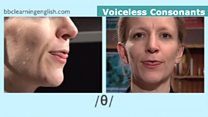Unit 17: Towards Advanced
Grammar, news, vocabulary and pronunciation
Select a unit
- 1 Towards advanced
- 2 Towards advanced
- 3 Towards advanced
- 4 Towards advanced
- 5 Towards advanced
- 6 Towards advanced
- 7 Towards advanced
- 8 Towards advanced
- 9 Towards Advanced
- 10 Towards Advanced
- 11 Towards Advanced
- 12 Towards Advanced
- 13 Towards Advanced
- 14 Towards Advanced
- 15 Towards Advanced
- 16 Towards Advanced
- 17 Towards Advanced
- 18 Towards Advanced
- 19 Towards Advanced
- 20 Towards Advanced
- 21 Towards Advanced
- 22 Towards Advanced
- 23 Towards Advanced
- 24 Towards Advanced
- 25 Towards Advanced
- 26 Towards Advanced
- 27 Towards Advanced
- 28 Towards Advanced
- 29 Towards Advanced
- 30 Towards Advanced
Session 5
Tim's Pronunciation Workshop: plosives
What are plosives - and how do fluent speakers of English pronounce them? Tim explains...
Activity 1
Tim's Pronunciation Workshop: Plosives
I love travelling...
Tim's back in his pronunciation workshop. This time he's finding out about plosives in natural spoken English - and he's wondering which country he'd like to visit next...
To do
Take a look at the video, then try the activity to do some practice.
Watch the video and complete the activity

Tim
Hi. I'm Tim and this is my pronunciation workshop. Here I'm going to show you how English is really spoken. Come on, let's go inside. Wow. Isn't the world an amazing place? Look how many countries there are! Well – at least ten! Do you like travelling? How many countries have you visited? Now, is there any particular place, or country, that you'd like to visit? This is what the people of London told us when we asked them that same question.
Voxpops
I'd like to visit Iceland.
I'd like to visit South America.
I'd like to visit Spain and Greece.
I'd love to go to Egypt.
Tim
The contraction 'I'd' ends in the sound /d/, doesn’t it? Or does it? Listen again - can you fully hear the /d/?
Voxpops
I'd like to visit Iceland.
I'd like to visit South America.
I'd like to visit Spain and Greece.
I'd love to go to Egypt.
Tim
We make the sounds of English in different ways, using different parts of our mouths. There's a group of consonants called plosives, and if this sounds a bit like the word 'explosion', well, that's not a bad way of remembering it. Plosive sounds are made by suddenly releasing air that has been blocked by various parts of the mouth. The sound /d/ is one of these plosives. The others are /b/, /t/, /p/, /k/ and /g/. But in fluent, everyday speech, when one word ends in a plosive sound and the next begins in another consonant sound, we don’t always hear the release of the plosive sound. 'I'd like to', becomes 'Idliketuh'. This is called 'an unreleased stop', or, if you want to get really technical, 'a stop with no audible release'. Here are some more examples.
Examples
How about a quick chat?
You should thank her.
It was a sad time in his life.
Why don't you sit down?
Tim
Right, so you've heard the examples, and now it's your turn. You know the drill by now: listen and repeat.
Examples
How about a quick chat?
You should thank her.
It was a sad time in his life.
Why don't you sit down?
Tim
Well done. And remember, if you want to learn more about this, then please visit our website, bbclearningenglish.com. And that is about it from the pronunciation workshop for this week. I'll see you soon. Bye bye! Now, if you were to ask me where I'd like to visit next… well – anywhere! I just love travelling. Now let's see if we can find my next destination. Oww! I hurt my finger… again!
To do
So that's a look at plosives in natural spoken English. Now try this activity to get some more practice.
The plosives game
8 Questions
In this game, each clip contains a word ending in an plosive sound - written in BLOCK CAPITALS - followed by a word that begins with a consonant. Does the speaker fully release (aspirate) the plosive at the end of the first word, or is it semi-released (not fully aspirated)? You decide...
Help
Activity
In this game, each clip contains a word ending in an plosive sound - written in BLOCK CAPITALS - followed by a word that begins with a consonant. Does the speaker fully release (aspirate) the plosive at the end of the first word, or is it semi-released (not fully aspirated)? You decide...
Hint
Can you hear a release of air at the end of the word in BLOCK CAPITALS?Question 1 of 8

Help
Activity
In this game, each clip contains a word ending in an plosive sound - written in BLOCK CAPITALS - followed by a word that begins with a consonant. Does the speaker fully release (aspirate) the plosive at the end of the first word, or is it semi-released (not fully aspirated)? You decide...
Hint
Can you hear a release of air at the end of the word in BLOCK CAPITALS?Question 2 of 8

Help
Activity
In this game, each clip contains a word ending in an plosive sound - written in BLOCK CAPITALS - followed by a word that begins with a consonant. Does the speaker fully release (aspirate) the plosive at the end of the first word, or is it semi-released (not fully aspirated)? You decide...
Hint
Can you hear a release of air at the end of the word in BLOCK CAPITALS?Question 3 of 8

Help
Activity
In this game, each clip contains a word ending in an plosive sound - written in BLOCK CAPITALS - followed by a word that begins with a consonant. Does the speaker fully release (aspirate) the plosive at the end of the first word, or is it semi-released (not fully aspirated)? You decide...
Hint
Can you hear a release of air at the end of the word in BLOCK CAPITALS?Question 4 of 8

Help
Activity
In this game, each clip contains a word ending in an plosive sound - written in BLOCK CAPITALS - followed by a word that begins with a consonant. Does the speaker fully release (aspirate) the plosive at the end of the first word, or is it semi-released (not fully aspirated)? You decide...
Hint
Can you hear a release of air at the end of the word in BLOCK CAPITALS?Question 5 of 8

Help
Activity
In this game, each clip contains a word ending in an plosive sound - written in BLOCK CAPITALS - followed by a word that begins with a consonant. Does the speaker fully release (aspirate) the plosive at the end of the first word, or is it semi-released (not fully aspirated)? You decide...
Hint
Can you hear a release of air at the end of the word in BLOCK CAPITALS?Question 6 of 8

Help
Activity
In this game, each clip contains a word ending in an plosive sound - written in BLOCK CAPITALS - followed by a word that begins with a consonant. Does the speaker fully release (aspirate) the plosive at the end of the first word, or is it semi-released (not fully aspirated)? You decide...
Hint
Can you hear a release of air at the end of the word in BLOCK CAPITALS?Question 7 of 8

Help
Activity
In this game, each clip contains a word ending in an plosive sound - written in BLOCK CAPITALS - followed by a word that begins with a consonant. Does the speaker fully release (aspirate) the plosive at the end of the first word, or is it semi-released (not fully aspirated)? You decide...
Hint
Can you hear a release of air at the end of the word in BLOCK CAPITALS?Question 8 of 8

Excellent! Great job! Bad luck! You scored:
End of Unit 17
We hope that was useful. In Unit 18, Dan will be looking at more advanced learner mistakes in Masterclass. In News Review and LingoHack you can find out which words are making the headlines - and Tim will be back with the pronunciation workshop as usual. See you there!
Session Vocabulary
Plosives
Plosive sounds are made by suddenly releasing air that has been blocked by various parts of the mouth. The sounds /d/ /b/, /t/, /p/, /k/ and /g/ are all plosives. But in fluent, everyday speech, when one word ends in a plosive sound and the next begins in another consonant sound, we don’t always hear the release of the plosive sound.Some examples of phrases where this might happen include:
- How about a quick chat?
- You should thank her.
- Why don't you sit down?


